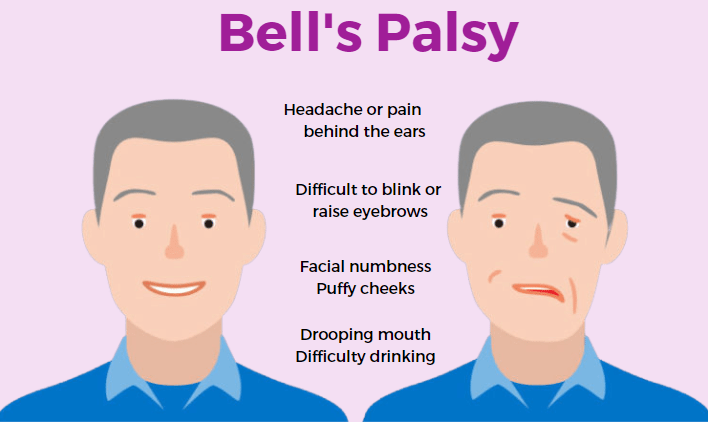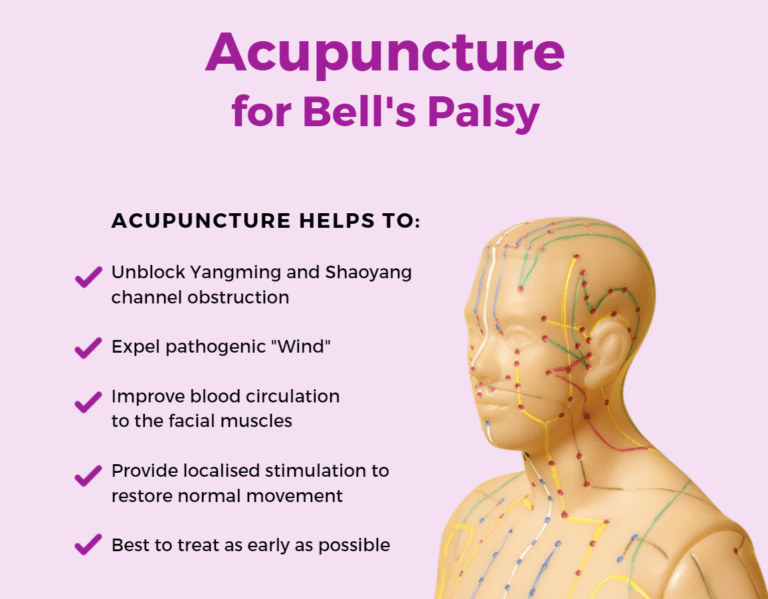What is Bell’s palsy
Bell’s palsy or “Deviated mouth and eye” in Traditional Chinese Medicine (TCM), is one of the most common disorders affecting the facial nerves, resulting in weakness or paralysis on one side of the face. The paralysis causes distortion of the face and interferes with normal functions, such as closing the eye, eating and drinking.
In most cases, the weakness is temporary and the condition significantly improves over weeks. Common Bell’s palsy treatments in Traditional Chinese Medicine include herbal medications to manage conditions relating to the nervous system and gentle massages on the afflicted areas of the face to help alleviate the ailment. At Thomson Chinese Medicine, our physicians also utilise acupuncture treatment to help treat patients with Bell’s palsy.

How does Bell’s palsy occur according to TCM
In TCM, the diagnosis of Bell’s palsy is due to a “Wind” factor. This “Wind” attacks the meridian channels of the face which are in charge of transporting Qi and blood to nourish the muscles in the face. This is more likely to happen if you have an underlying Qi (vital energy) deficiency.
The “Wind” factor can be further categorised into 2 specific types – Wind-cold and Wind-heat. Following an invasion of Wind-cold from cold weather or prolonged exposure to aircon, this can lead to constriction of facial vessels, causing stagnation of blood and lymph circulation, resulting in edema of the face. Whereas Wind-heat invasion often results in fever or sore throat and may be accompanied by ear distention and pain.
How acupuncture can help with Bell’s palsy
Acupuncture therapy is the most widely used Bell’s palsy treatment in China and throughout the world.
The condition involves inflammation of the 7th cranial nerve affecting regions of the stylomastoid foramen or the facial canal. This corresponds to the ancient TCM as Yang Ming and Shao Yang channel obstruction.
One of the treatment goals is to expel Wind in these meridians. By stimulating the localised area of facial muscles, acupuncture can restore movement to facial muscles by invigorating Qi and promoting blood circulation to the face.
Acupuncture treatment for Bell’s palsy also helps reduce the inflammation and swelling of the facial nerve, thus alleviating its effects.
Consistent acupuncture treatment once to twice per week is recommended to expedite the recovery process and enhance nerve function recovery.
Studies suggest that acupuncture is associated with increased partial or complete recovery rates compared with people who receive drug therapies. However, more high-quality research is needed to confirm these findings due to poor study designs. Nevertheless, despite the poor quality of studies, acupuncture seems to be effective in managing Bell’s palsy, especially in the initial acute stage.

3 stages of acupuncture treatment
Bell’s palsy treatment differs according to the 3 stages of the disease. The most important factor is to treat the condition as early as possible, as acupuncture is most effective in the initial acute stage.
- Acute stage
- Within 10 days of the onset of Bell’s Palsy. In the initial stage, Wind-cold or Wind-heat first attacks the Shao Yang meridian which refers to San Jiao and Gallbladder meridians that run along the sides of the face. Hence, acupoints on Shao Yang meridians will be selected accordingly.
- Resting stage
- Within 3 months of the onset of Bell’s Palsy. As Qi strengthens during this stage, stronger Qi can fight off the pathogenic factors and most people will recover well in this stage after receiving the appropriate Bell’s palsy treatment. At this point, the pathogenic factor enters a deeper level to the Yang Ming meridian, hence acupoint selections will be focused on the Yang Ming meridian.
- Recovery stage
- More than 3 months from the onset of Bell’s Palsy. Due to the long period of time since the onset, the pathogenic factor has travelled deeper into the meridians, depleting the Qi and blood in the body. This results in a lack of nourishment for the facial muscles. Symptoms are often complicated and can lead to facial muscle spasms and adhesion of connective tissues, resulting in permanent changes in facial expressions. Local acupoints on the face as well as Zang organs acupoints are selected to treat the root cause.
Getting the appropriate Bell’s palsy treatment is key
A large-scale clinical trial that investigated the effects of acupuncture treatment on Bell’s palsy indicated that acupuncture with stronger needle stimulation could be advantageous compared with non-stimulated acupuncture in the acute stage of Bell’s palsy.
Likewise, in another small treatment clinical group, the acupuncture group exhibited greater improvements in the Facial Disability Index and stiffness scale compared with the non-acupuncture group after 8 weeks. This shows that acupuncture had better therapeutic effects on the social and physical aspects of the sequelae of Bell’s palsy.
When it comes to TCM acupuncture treatment, the essential element is to establish facial symmetry. Incomplete or late recovery can often result in social and physical disabilities. Therefore, it is crucial to consult a TCM physician early so he or she can diagnose and provide the appropriate Bell’s palsy treatment to improve blood circulation, control nerve inflammation and reduce edema of the face.
For a consultation, book an appointment at Thomson Chinese Medicine.
Physician Jun Negoro
Traditional Chinese Medicine
Thomson Chinese Medicine (TCM Paragon Medical Centre) and 1 other
English, Mandarin
Alliance MediNet

